engine overheat PONTIAC BONNEVILLE 1993 Owners Manual
[x] Cancel search | Manufacturer: PONTIAC, Model Year: 1993, Model line: BONNEVILLE, Model: PONTIAC BONNEVILLE 1993Pages: 322, PDF Size: 16.31 MB
Page 5 of 322
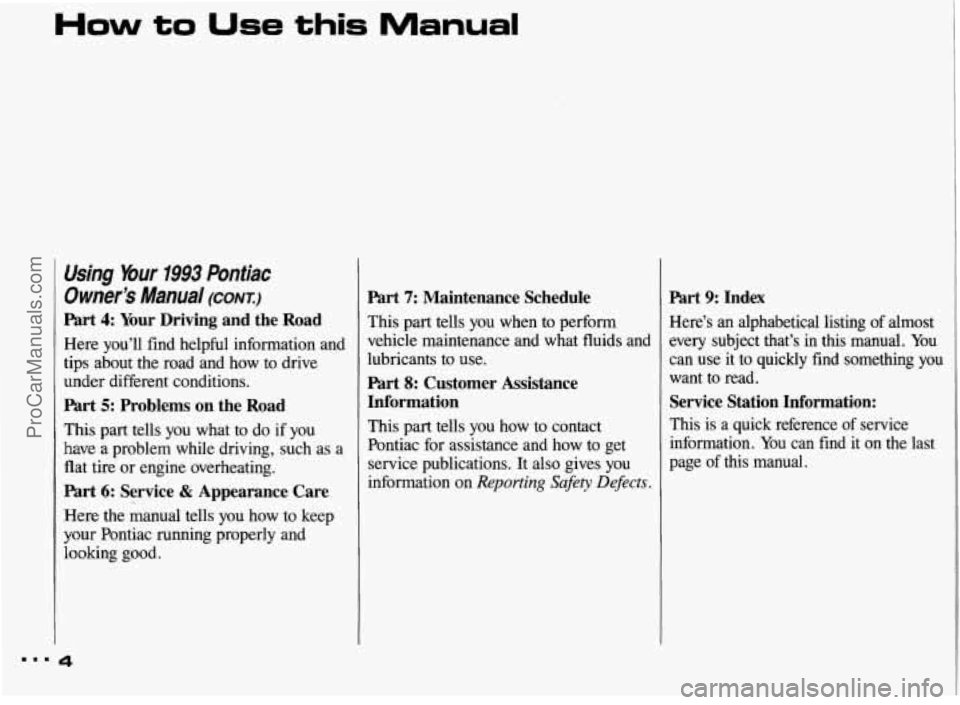
How to Use this Manual
Using bur 1993 Pontiac
Owner’s Manual (CONT.)
Part 4: Your Driving and the Road
Here you’ll find helpful information and
tips about the road and how to drive
under different conditions.
Part 5: Problems on the Road
This part tells you what to do if you
have a problem while driving, such as a
flat tire or engine overheating.
Part 6: Service & Appearance Care
Here the manual tells you how to keep
your Pontiac running properly and
looking good.
Part 7: Maintenance Schedule
This part tells you when to perform
vehicle maintenance and what fluids and
lubricants to use.
Part 8: Customer Assistance
Information
This part tells you how to contact
Pontiac for assistance and how to get
service publications. It also gives you
information on
Reporting Safety Defects.
Part 9: Index
Here’s an alphabetical listing of almost
every subject that’s
in this manual. You
can use it to quickly find something you
want to read.
Service Station Information:
This is a quick reference of service
information. You can find it on the last
page of this manual.
.I. 4
ProCarManuals.com
Page 61 of 322
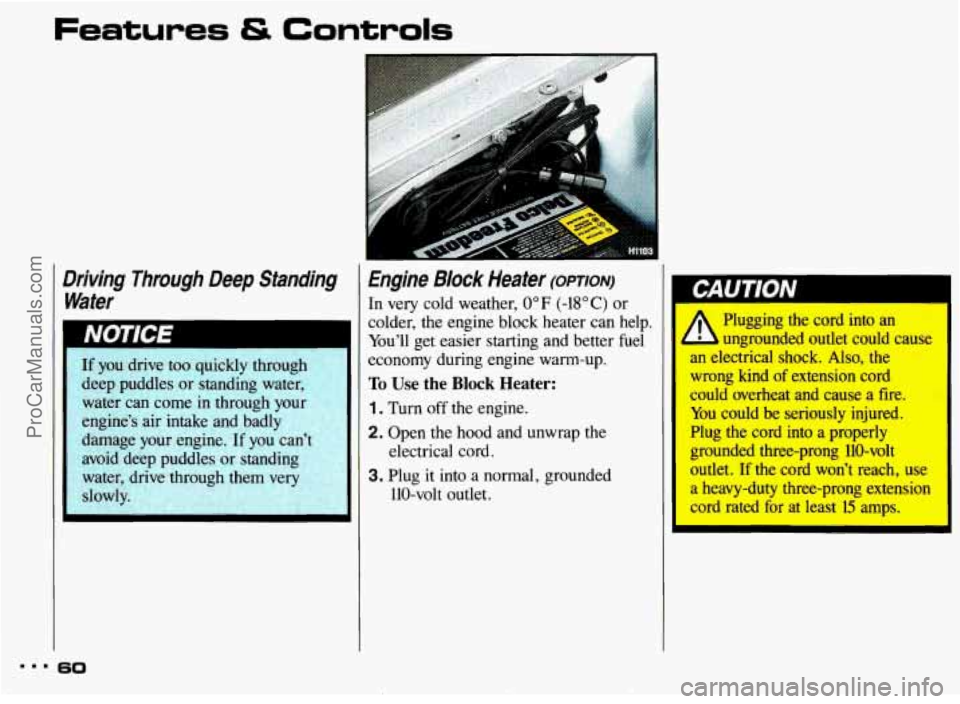
Features & Controls
Driving Through Deep Standing Water
.. - .
If you drive too quickly through
deep puddles or standing water,
water can come in through your
engine’s air intake and badly
damage
your engine. If you can’t
avoid deep puddles or standing
water, drive through them very
slowly.
Engine Block Heater (opTIoN)
In very cold weather, 0°F (-18” C) or
colder,
the engine block heater can help.
You’ll get easier starting and better fuel
economy during engine warm-up.
To Use the Block Heater:
1 . Turn off the engine.
2. Open the hood and unwrap the
3. Plug it into a normal, grounded
electrical
cord.
110-volt outlet.
b!!
A
Plugging the cord into an
ungrounded outlet could cause
an electrical shock. Also, the
wrong kind of extension cord
could overheat and cause a fire. You could be seriously injured.
Plug the cord into a properly
grounded three-prong 110-volt
outlet. If the cord won’t reach, use
a heavy-duty three-prong extension
cord rated for at least 15 amps.
... 60
ProCarManuals.com
Page 67 of 322
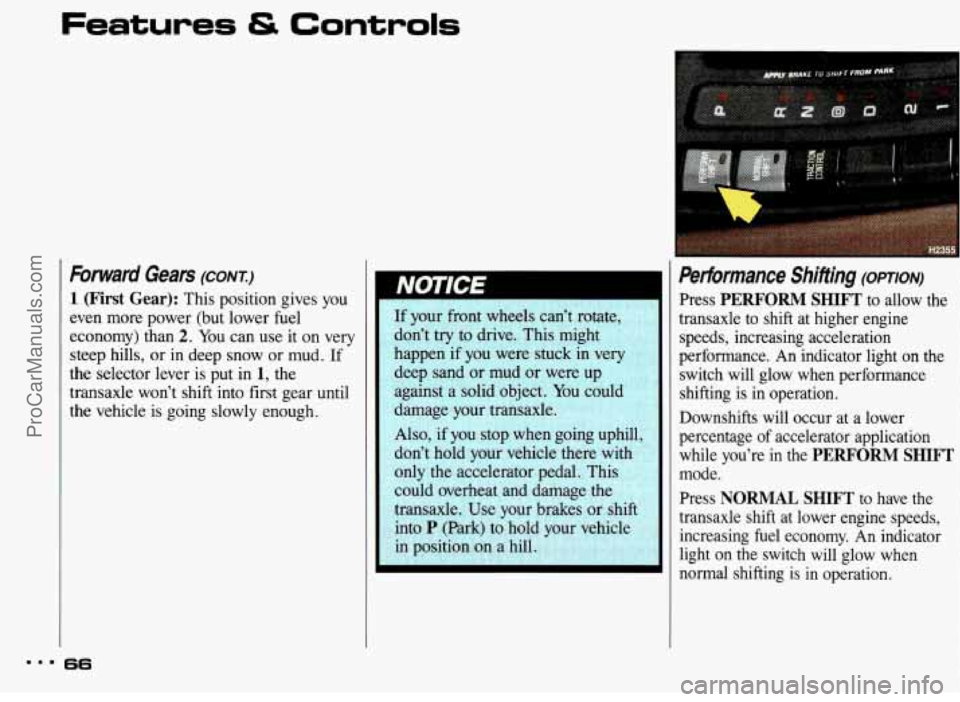
Features & Controls
Forward Gears (CONT.)
1 (First Gear): This position gives you
even more power (but lower fuel
economy) than
2. You can use it on very
steep hills, or in deep snow or
mud. If
the selector lever is put in
1, the
transaxle won’t shift into first gear until
the vehicle is going slowly enough.
66
If your front wheels can’t rotate,
don’t try to drive. This might
happen if you were stuck
in very
deep sand or mud or were up
against a solid object. You could
damage your transaxle.
Also,
if you stop when going uphill,
don’t hold your vehicle there with
only the accelerator pedal. This
could overheat and damage the
transaxle.
Use your brakes or shift
into
P (Park) to hold your vehicle
in position
on a hill.
Performance Shifting (opTIoN)
Press PERFORM SHIFT to allow the
transaxle to shift at higher engine
speeds, increasing acceleration
performance. An indicator light on the
switch will glow when performance
shifting is in operation.
Downshifts will occur at a lower
percentage
of accelerator application
while you’re in the
PERFORM SHIFT
mode.
Press
NORMAL SHIFT to have the
transaxle shift at lower engine speeds, increasing fuel economy. An indicator
light on the switch will glow when
normal shifting is in operation.
ProCarManuals.com
Page 71 of 322
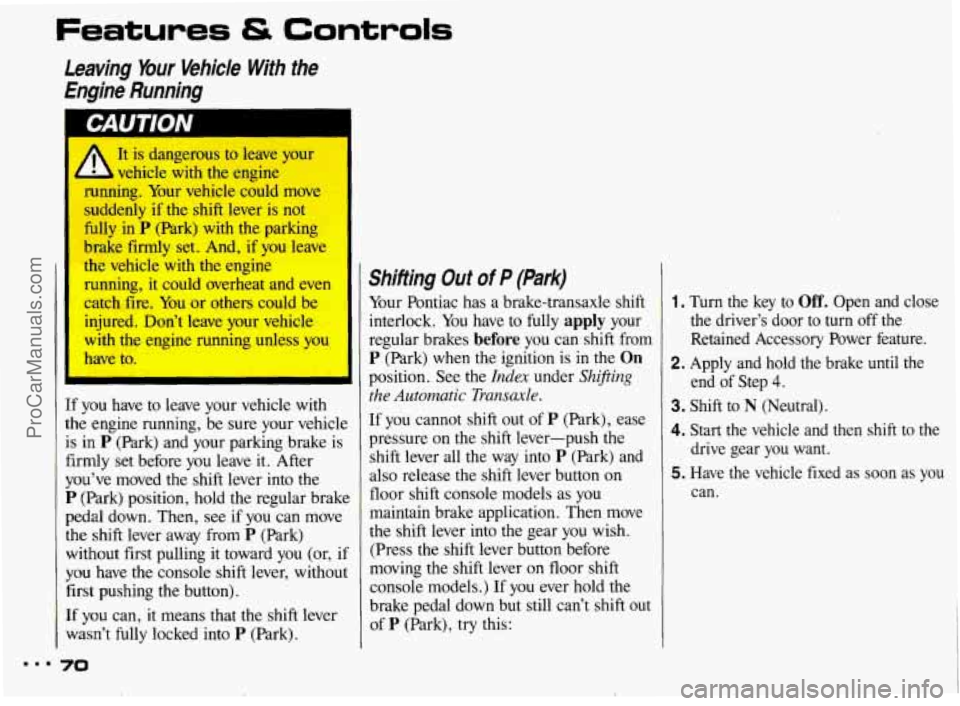
Features & Controls
Leaving Your Vehicle With the Engine Running
It is dangerous to leave your
vehicle with the engine
nning. Your vehicle could move
ddenly if the shift lever is not
dy in P (Park) with the parking
brake firmly set. And, if
you leave
the vehicle with the engine
running,
it could overheat and even
catch fire. You or others could be
injured. Don’t leave your vehicle
with the engine running unless you
have to.
I
If you have to leave your vehicle with
the engine running, be sure your vehicle
is in
P (Park) and your parking brake is
firmly set before you leave
it. After
you’ve moved the shift lever into the
P (Park) position, hold the regular brake
pedal down. Then, see if you can move
the shift lever away from
P (Park)
without first pulling it toward you (or, if
you have the console shift lever, without
first pushing the button).
If you can, it means that the shift lever
wasn’t fully locked into
P (Park).
70
Shifting Out of P (Park)
Your Pontiac has a brake-transaxle shift
interlock. You have to fully
apply your
regular brakes
before you can shift from
P (Park) when the ignition is in the On
position. See the Index under Shifting
the Automatic Transaxle.
If you cannot shift out of P (Park), ease
pressure
on the shift lever-push the
shift lever all the way into
P (Park) and
also release the shift lever button on
floor shift console models as you
maintain brake application. Then move
the shift lever into the gear you wish.
(Press the shift lever button before
moving the shift lever on floor shift
console models.)
If you ever hold the
brake pedal down but still can’t shift out
of
P (Park), try this:
1. Turn the key to Off. Open and close
the driver’s door to
turn off the
Retained Accessory Power feature.
2. Apply and hold the brake until the end of Step
4.
3. Shift to N (Neutral).
4. Start the vehicle and then shift to the
drive gear you want.
5. Have the vehicle fixed as soon as you
can.
ProCarManuals.com
Page 102 of 322
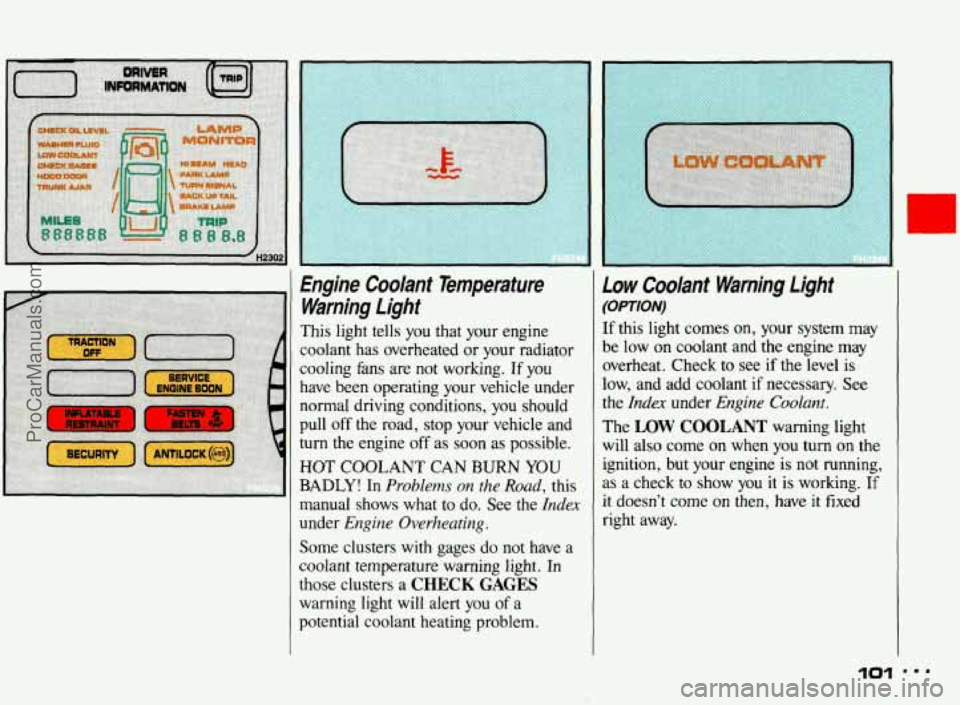
Engine Coolant Temperature Warning Light
This light tells you that your engine
coolant has overheated
or your radiator
cooling fans are
not working. If you
have been operating your vehicle under
normal driving conditions, you should
pull off the road, stop your vehicle and
turn the engine
off as soon as possible.
HOT
COOLANT CAN BURN YOU
BADLY!
In Problems on the Road, this
manual shows what to do. See the
Index
under Engine Overheating.
Some clusters with gages do not have a
coolant temperature warning light.
In
those clusters a CHECK GAGES
warning light will alert you of a
potential coolant heating problem.
Low Coolant Warning light
(OPT/ON)
If this light comes on, your system may
be low
on coolant and the engine may
overheat. Check to see
if the level is
low, and add coolant if necessary. See
the
Index under Engine Coolant.
The LOW COOLANT warning light
will also come on when
you turn on the
ignition, but your engine is not running,
as a check to show you it is working.
If
it doesn’t come on then, have it fixed
right away.
101
ProCarManuals.com
Page 108 of 322
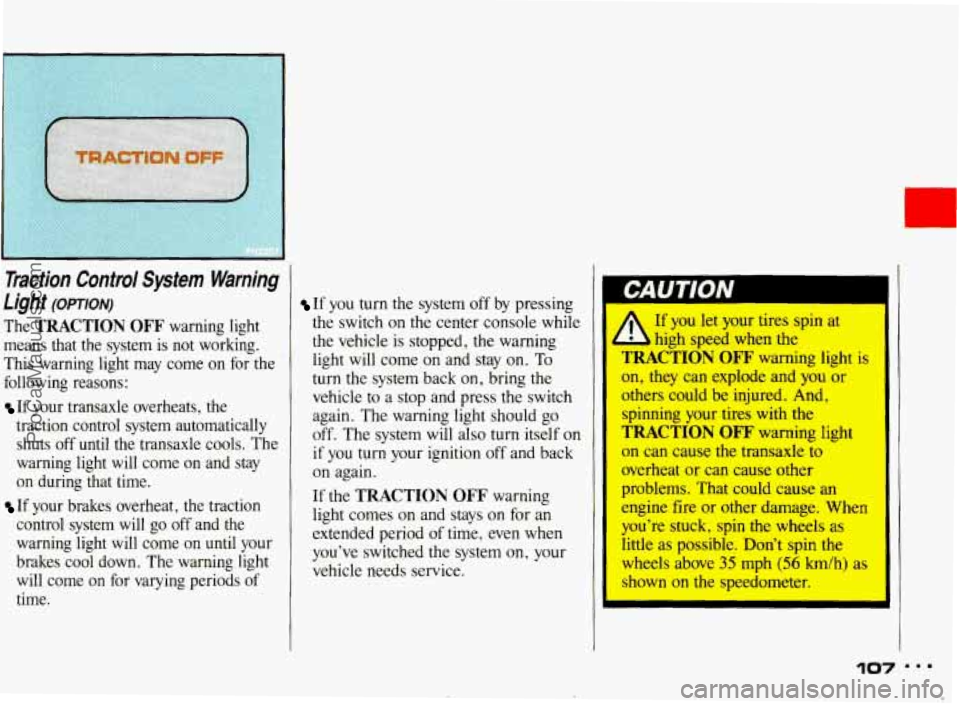
L
Traction Control System Warning
Light
(OPTION)
The TRACTION OFF warning light
means that the system is not working.
This warning light may come on for the
following reasons:
If your transaxle overheats, the
traction control system automatically shuts off
until the transaxle cools. The
warning light will come on and stay
on during that time.
If your brakes overheat, the traction
control system will go off and the
warning light will come
on until your
brakes cool down. The warning light
will come on for varying periods of
time.
If you turn the system off by pressing
the switch on the center console while
the vehicle is stopped, the warning
light will come on and stay on. To
turn the system back on, bring the
vehicle to
a stop and press the switch
again. The warning light should go
off. The system will also turn itself on
if you turn your ignition off and back
on again.
If the
TRACTION OFF warning
light comes on and stays on for an
extended period
of time, even when
you've switched the system on, your
vehicle needs service.
If you let your tires spin at
high sped when the
TRACTION OFF warning light is
on, they can explode and you or
othm could be injured. And,
spinning your tires with the
TRACTION OFF' warning light
on can cause the transaxle to
overheat or can cause other
problems. That could cause an
engine fire or other damage. When
you're stuck, spin the wheels as
little as possible. Don't spin the
wheels above 35 mph (56 h/h) as
shown on the speedometer.
e ProCarManuals.com
Page 110 of 322
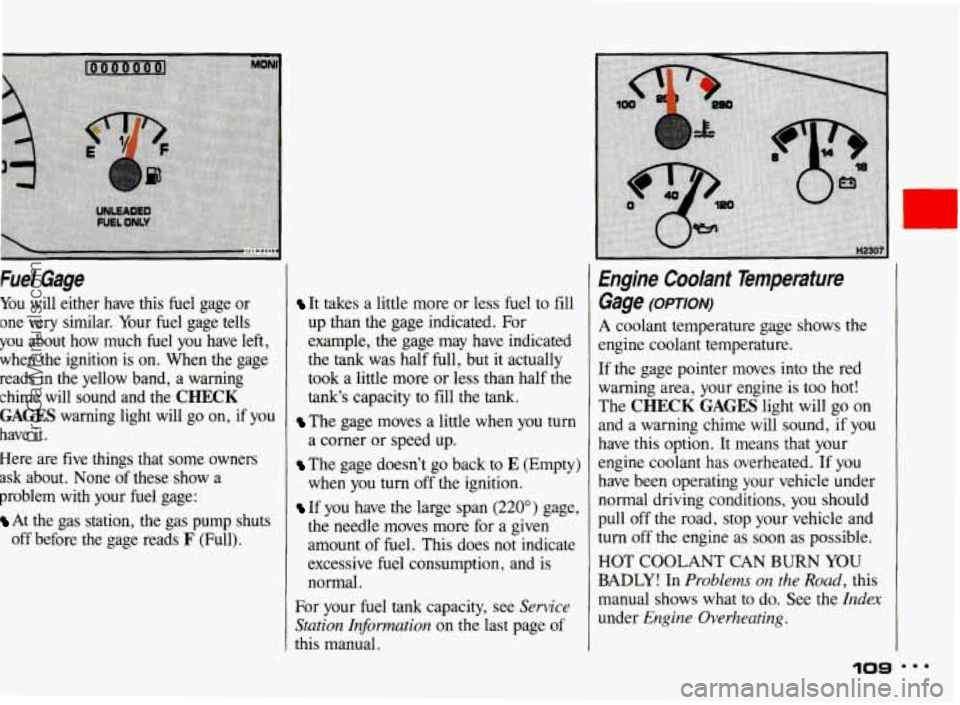
Fuel Gage
You will either have this fuel gage or
one very similar. Your fuel gage tells
you about how much fuel you have left,
when
the ignition is on. When the gage
reads in the yellow band, a warning
chime will sound and the
CHECK
GAGES warning light will go on, if you
have it.
Here are five things that some owners
ask about. None of these show a
problem with your fuel gage:
At the gas station, the gas pump shuts
off before the gage reads
F (Full).
It takes a little more or less fuel to fill
up than the gage indicated. For
example, the gage may have indicated
the
tank was half full, but it actually
took a little more or less than half the
tank's capacity to fill the tank.
The gage moves a little when you turn
a corner or speed up.
The gage doesn't go back to E (Empty)
when you turn off the ignition.
If you have the large span (220") gage,
the needle moves more for a given
amount
of fuel. This does not indicate
excessive fuel consumption, and is
normal.
For your fuel
tank capacity, see Sewice
Station Informution
on the last page of
this manual.
Engine Coolant Temperature
Gage
(OPTION)
A coolant temperature gage shows the
engine coolant temperature.
If the gage pointer moves into the red
warning area, your engine is too hot!
The
CHECK GAGES light will go on
and a warning chime will sound, if you
have this option. It means that your
engine coolant has overheated. If you
have been operating your vehicle under
normal driving conditions, you should
pull off the road, stop your vehicle and
turn off
the engine as soon as possible.
HOT COOLANT CAN
BURN YOU
BADLY! In Problems on the Road, this
manual shows what to do. See the
Index
under Engine Overheating.
10s
ProCarManuals.com
Page 156 of 322
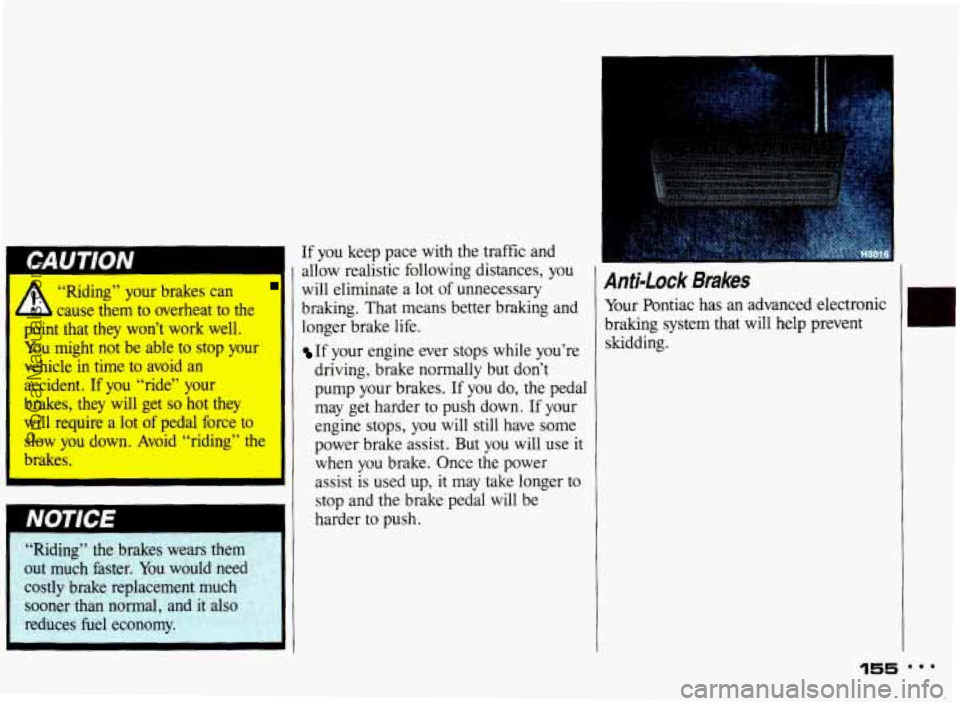
“Riding” your brakes can
1 cause them to overheat to the
point that they won’t work well.
You might not be able to stop your
vehicle in time to avoid an
accident. If you “ride” your
brakes, they will get so hot they
will require a lot of pedal force to
sIow you down. Avoid “riding” the
brakes.
’
I NOTICE I
“Riding” the brakes wears them
out much faster. You would need
costly brake replacement much sooner than normal, and
it also
reduces fuel economy.
!
If you keep pace with the traffic and
allow realistic following distances, you
will eliminate a lot
of unnecessary
braking. That means better braking and
longer brake life.
If your engine ever stops while you’re
driving, brake normally but don’t
pump your brakes. If you do,
the pedal
may get harder to push down.
If your
engine stops, you will still have some
power brake assist. But
you will use it
when you brake. Once the power
assist is used up,
it may take longer to
stop and the brake pedal will be
harder to push.
Anti-Lock Brakes
Your Pontiac has an advanced electronic
braking system that will help prevent
skidding.
ProCarManuals.com
Page 190 of 322
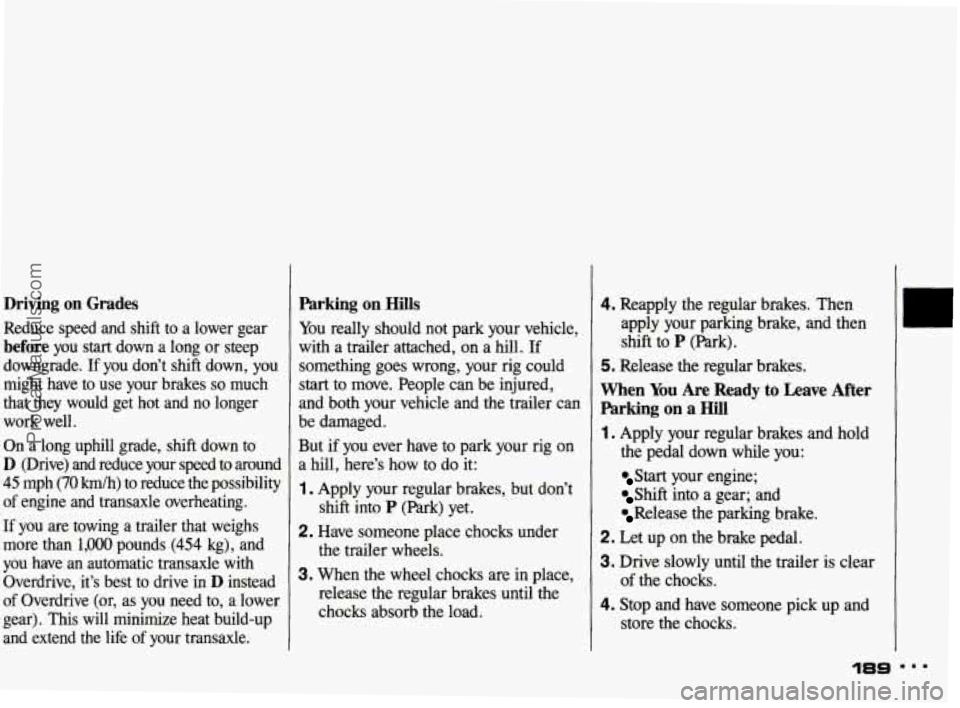
Driving on Grades
Reduce speed and shift to a lower gear
before you start down a long or steep
downgrade. If you don’t shift down, you
might have to use your brakes
so much
that they would get hot and no longer
work well.
On a long uphill grade, shift down to
D (Drive) and reduce your speed to around
45 mph (70 km/h) to reduce the possibility
of engine and transaxle overheating.
If you are towing a trailer that weighs
more than
1,000 pounds (454 kg), and
you have an automatic transaxle with
Overdrive, it’s best
to drive in D instead
of Overdrive (or, as you need to, a lower
gear). This will minimize heat build-up
and extend the life
of your transaxle.
Parking on Hills
You really should not park your vehicle,
with a trailer attached, on a hill. If
something goes wrong, your rig could
start to move. People can be injured,
and both your vehicle and the trailer can
be damaged.
But if you ever have to park your rig on
a hill, here’s how to do it:
1. Apply your regular brakes, but don’t
shift into
P (Park) yet.
2. Have someone place chocks under
the trailer wheels.
3. When the wheel chocks are in place,
release the regular brakes until the
chocks absorb the load.
4. Reapply the regular brakes. Then
apply your parking brake, and then
shift to
P (Park).
5. Release the regular brakes.
When You Are Ready to Leave After
Parking on a Hill
1, Apply your regular brakes and hold
the pedal down while you:
Start your engine;
Shift into a gear; and
Release the parking brake.
2. Let up on the brake pedal.
3. Drive slowly until the trailer is clear
4. Stop and have someone pick up and
of the chocks.
store the chocks.
ProCarManuals.com
Page 192 of 322
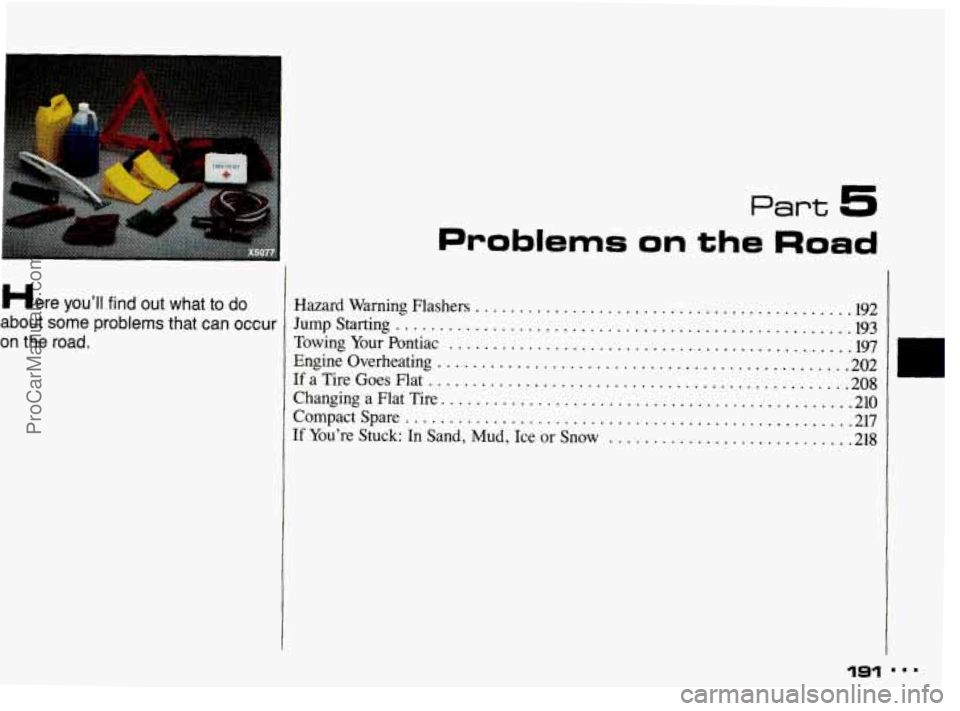
Here you’ll find out what to do
about
some problems that can occur
on the road .
Part 5
Problems on the Road
........................................... Hazard Warning Flashers 192
Jumpstarting
.................................................... 193
Towing Your Pontiac
197
Engine Overheating 202
If a Tire Goes Flat 208
Changing a Flat Tire 210
Compactspare
................................................... 217
..............................................
...............................................
................................................
...............................................
If You’re Stuck: In Sand, Mud, Ice or Snow .......................... 218
ProCarManuals.com